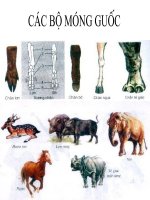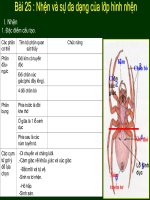Tải Giáo án tiếng Anh lớp 9 Tuần 16 sách mới - Giáo án điện tử môn tiếng Anh 9 theo tuần
Bạn đang xem bản rút gọn của tài liệu. Xem và tải ngay bản đầy đủ của tài liệu tại đây (119.83 KB, 7 trang )
<span class='text_page_counter'>(1)</span><div class='page_container' data-page=1>
<b>GIÁO ÁN TIẾNG ANH LỚP 9 </b>
<b> TUẦN 16</b>
<b>NĂM HỌC 2019 - 2020</b>
<b>Period: 46 Week: 16</b>
<b>Unit 6: VIET NAM:THEN AND NOW</b>
<i><b>Lesson 3 - A CLOSER LOOK 2</b></i>
<b>I. OBJECTIVES: By the end of this Unit, students will be able to:</b>
• use the past perfect correctly
<i>• use the structure adj + to-infinitive and adj + that-clause correctly</i>
<b>II . PREPARATION: sub -board, pictures, cassette </b>
<b>III. PROCEDURES: </b>
<b>Teacher’s and students’ activities</b> <b>Content</b>
<b>Activity 1: </b>
- Ask Ss to work individually to fill in the blanks.
Check the answers as a class.
<b>Activity 2:</b>
- Have Ss work in pairs. Together they write the
questions and answers. Have some Ss write their
sentences on the board. Each student may write
one or two pairs of questions and answers to
save time. Have other Ss give comments. Confirm
the correct sentences.
<i>Key:</i>
1. had been
2.had played
3. had (you) used
4. had (only) seen
5. had had
6. had experienced
1. Key:
1.<i>-What family groups had </i>
Vietnamese
people lived in before 1990?
<i>- They had lived in extended </i>
families.
2. <i>-How had people in Viet Nam </i>
travelled before the first motorbike
was imported?
<i>- They had travelled by bicycle.</i>
</div>
<span class='text_page_counter'>(2)</span><div class='page_container' data-page=2>
Ask Ss to read the speech bubbles from the
conversation in Getting Started, then have them read
the structures and examples in the grammar box
carefully. Help them with the meaning of the
adjectives if necessary. Then ask some more able Ss
to retell the rules and give examples. Correct their
sentences if necessary.
<b>Activity 3:</b>
- Have Ss work in pairs to do the matching exercise.
Allow pairs to share answers with other pairs. Then
check their answers as a class.
<b>Activity 4:</b>
- Have Ss work in pairs to do the gap-fill exercise.
Allow pairs to share answers with other pairs. Then
check their answers as a class, noting all the
possible options.
<b>Activity 5:</b>
- Have Ss work in groups of about four and give
each group an A3-size sheet. Ask them to write the
sentences leaving a large space between each one.
Then tell Ss to stick the sheets on the wall. Each
1986?
<i>- They had had a harder life.</i>
4. <i>-Where had your family spent </i>
holidays before 2005?
<i>-We had spent our holidays only in </i>
Viet Nam before then.
5. <i>-Who had ruled Viet Nam right </i>
before the Tran dynasty?
<i>-Ly Chieu Hoang had ruled the </i>
country before the Tran dynasty.
<i><b>Adjective + to-infinitive/Adjective</b></i>
<i><b>+ that-clause</b></i>
<i>Key:</i>
1. F 2. A 3. B 4. E 5. D 6. C
<i>Key:</i>
1. glad/pleased
2. sorry
3.relieved/sorry/pleased
4. sure/certain
5.surprised/astonished
6. relieved/pleased
<i>Key:</i>
</div>
<span class='text_page_counter'>(3)</span><div class='page_container' data-page=3>
group moves around clockwise to read the other
groups’ answers and, if necessary, correct the
sentences by writing any corrections on a sticky
note against each sentence. Check the answers as a
class. Note that this kind of peer review is effective
and can be used in many different teaching
situations.
<b>Activity 6:</b>
- Ask Ss to work individually to finish the
sentences. For some classes it may be better to have
Ss choose just one or two sentences to focus on,
rather than do them all. Allow them to share their
ideas with a partner.
Then ask some Ss to read out their sentences.
Correct their sentences if necessary.
done well in the exam.
2. I am sorry that our parents had
very poor school facilities.
3. Everyone was glad that the
government had decided to invest
more in education.
4. Everyone is aware that it will be
much safer to have elevated
walkways and underpass systems for
pedestrians.
5. All of us are delighted that life in
the countryside has improved
considerably.
<i>Suggested answers:</i>
1. to support the victims after the
disaster
2. be able to build the country into a
powerful one
3. Viet Nam has good potential for
tourism
4. there would be less land for
agriculture in Viet Nam
5. non-academic subjects are also
significant
6. learn that some of his students
could not get scholarships
<b>IV- HOMEWORK:</b>
-Write new words then learn them by heart.
-Copy the exercise into notebooks.
-Prepare <b>COMMUNICATION</b>
</div>
<span class='text_page_counter'>(4)</span><div class='page_container' data-page=4>
<b>Unit 6: VIET NAM:THEN AND NOW</b>
<i><b>Lesson 4 - COMMUNICATION</b></i>
<b>I. OBJECTIVES: By the end of this Unit, students will be able to:</b>
• read for general and specific information about the tram system in Ha Noi then
and now.
<b>II . PREPARATION: sub -board, pictures, cassette </b>
<b>III. PROCEDURES: </b>
<b>Teacher’s and students’ activities</b> <b>Content</b>
<b>Activity 1: </b>
-Have Ss skim-read the posts individually. In pairs,
Ss compare how many ideas from the posts they can
remember. Then they can read them a second time
more slowly for detail.
<b>Activity 2:</b>
Put Ss in groups of three. Tell them that they can
look back at the posts and each group member
reports on one post as in the example. Afterwards,
ask some Ss to retell the posts to the class. Correct
them if necessary.
Books
<i>Suggested answers:</i>
<i>- Charles is from France. He said </i>
<i>that the rest time he had been to </i>
<i>Viet Nam was in 1965. He said that </i>
<i>many people were/had been </i>
<i>illiterate then but he was astonished</i>
<i>that after nearly 30 years there was </i>
<i>no more illiteracy although the </i>
<i>population had nearly tripled. He </i>
<i>was also surprised to learn that the </i>
<i>country was one of the largest rice </i>
<i>exporting countries.</i>
</div>
<span class='text_page_counter'>(5)</span><div class='page_container' data-page=5>
<b>Activity 3:</b>
<b>- Have Ss work in groups. Ask them to focus on a </b>
couple of the suggestions in the table to discuss and
write down a few posts on a big sheet of paper. They
can pretend to be foreign visitors and use the posts
in 1 as a model. Set a time limit of ten minutes.
They should also decide which changes are the most
beneficial.
<b>Activity 4:</b>
-When the time is up, ask the groups to stick their
papers on the wall. Each group reports their best
post to the class, saying which changes have been
the most beneficial for the country. Vote for the best
posts.
<i>–High-rise buildings were </i>
<i>mushrooming.</i>
<b>IV- HOMEWORK:</b>
-Write new words then learn them by heart.
-Copy the exercise into notebooks.
-Prepare <b>SKILLS 1</b>
Period: 48 Week: 16
<b>Unit 6: VIET NAM:THEN AND NOW</b>
<i><b>Lesson 1 - SKILLS 1 </b></i>
<b>I. OBJECTIVES: By the end of this Unit, students will be able to:</b>
• talk about changes in transport in the neighbourhood and express opinions about
these changes
<b>II . PREPARATION: sub -board, pictures, cassette </b>
<b>III. PROCEDURES: </b>
<b>Teacher’s and students’ activities</b> <b>Content</b>
<b>Activity 1: </b>
-Ask Ss to look at the two pictures and discuss the
questions. Elicit the answers from Ss. Give Ss two
<i>Suggested answers:</i>
</div>
<span class='text_page_counter'>(6)</span><div class='page_container' data-page=6>
minutes to skim the article and compare their
answers with the information in the article.
<b>Activity 2:</b>
-Have Ss read the article to answer the questions in
pairs. Ask some Ss to share their answers.
<b>Activity 3:</b>
-Ask Ss to work individually. Remind them to pay
attention to key words in each statement. Then allow
them to share answers before checking as a class.
modern train.
- The tram would have been seen in
a town or city. These trains can be
seen nowadays in big, modern
cities.
- They are diferent in many ways:
+ the first has fewer compartments
(two or three) than the second
(four).
+ the first runs much more slowly.
+ the first is not air-conditioned
while the second is.
+ the first runs along tracks on the
ground at street level, while the
second runs on elevated tracks.
+ the first is powered by overhead
electricity wires, while the second
runs on electromagnetics.
<i>Key:</i>
1. In the 20th century.
2. It was a major means of transport
for Hanoians.
3. In 1990.
4. The population has increased
dramatically.
5. New rail systems including a
skytrain and a subway are under
way.
6. (Students’ own opinions)
</div>
<span class='text_page_counter'>(7)</span><div class='page_container' data-page=7>
Ask them to explain why some statements are false.
<b>Speaking</b>
<b>Activity 4:</b>
-This can be done as pair work or as a game. Divide
the class into two big groups. Members of each
group take turns to come to the board to add to the
list of different types of transport systems in Viet
Nam. Set a time limit of a few minutes. The group
with more words/phrases wins.
<b>Activity 5:</b>
-Ask Ss to work in pairs to do the discussion. Tell
them that they can use the information from 4 and
the examples in 5. Ask some pairs to present their
ideas to the whole class.
<b>IV- HOMEWORK:</b>
-Write new words then learn them by heart.
-Copy the exercise into notebooks.
<b>-Prepare SKILLS 2</b>
Mời bạn đọc tham khảo thêm tài liệu Tiếng Anh lớp 9 tại đây:
Bài tập Tiếng Anh lớp 9 theo từng Unit:
Bài tập Tiếng Anh lớp 9 nâng cao:
</div>
<!--links-->









